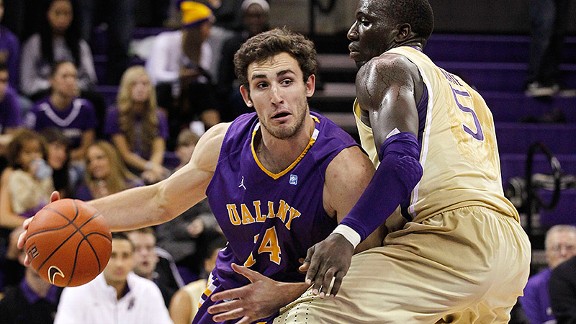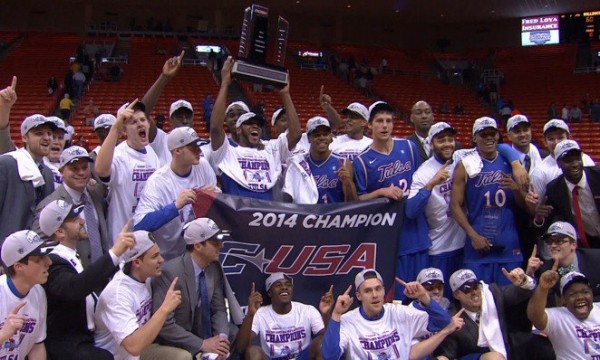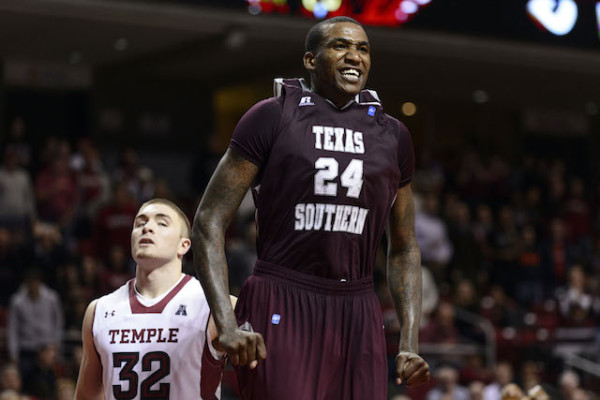Bracket Prep: Albany, Tulsa, Texas Southern
Posted by Tommy Lemoine on March 16th, 2014As we move through the final stages of Championship Week, we’ll continue to bring you short reviews of each of the automatic qualifiers to help you fill out your bracket next week. Here’s what you need to know about the most recent bid winners.
Albany

For the second straight season, Albany surprised the America East and is going dancing. (AP Photo/Elaine Thompson)
- America East Champion (18-14, 12-7)
- RPI/Pomeroy/Sagarin = #210/#195/#199
- Adjusted Scoring Margin = +0.2
- Likely NCAA Seed: #16
Three Bruce Pearls of Wisdom.
- For the second straight year, Albany capitalized on its home court advantage in the America East non-championship rounds before pulling off a road upset in the title game. That means the Great Danes – instead of league champion Vermont or preseason favorite Stony Brook – will represent the conference in the NCAA Tournament. The Catamounts or Seawolves would probably have been more serious upset threats (especially Vermont, once projected in the 13-seed range), but Albany is among the more experienced teams in the country and did go dancing last season, which never hurts.
- The Danes’ identity lies on the defensive end, where they held opponents to under one point per possession in conference play. Will Brown’s club switches between man defense and a stout 2-3 zone that gave Stony Brook all kinds of issues on Saturday, including a six minute stretch where the Seawolves failed to make a single field goal early in the second half. Albany is anchored inside by 6’10’’ center John Puk, whose defense against America East Player of the Year Jameel Warney showed he’s capable of holding his own against skilled big men – the kind he’ll surely face in the NCAA Tournament. Offensively, the team is led by Australian shooting guard Peter Hooley, who averages nearly 16 points per game and shoots 40 percent from behind the arc. Fellow Aussie Sam Rowley is the team’s leading rebounder and was the go-to scorer on Saturday – he averages 11 per night – while speedy point guard DJ Evans and small forward Gary Johnson also score in double figures.
- With an adjusted tempo of 63.3 possessions per game and an average offensive possession length of 19.3 seconds, the Danes look to methodically execute in the half-court and control the pace. The vast majority of their shots are taken from inside the arc – besides Hooley and Evans, no player has attempted more than 50 threes on the season – and they are proficient both at drawing fouls and making their free throws; Hooley ranked second in the conference at 86 percent from the stripe. Ultimately, though, Albany wins with its defense, preventing opponents from getting easy looks and cleaning up misses at a high rate. In their upset of Vermont, the Danes allowed the Catamounts to corral just 20 percent of their misses.
Best Case Scenario: Round of 64. Albany performed admirably against Duke in the NCAA Tournament last season, hanging around within single digits for much of the game’s first 20-25 minutes. Still, it took 60 percent three-point shooting just for that to happen, and the Danes were probably a better team a year ago. And whereas they were a 15-seed then, the 16 line is a more likely landing spot tonight. All that said, however, it was Albany that nearly pulled off the impossible against top-seeded UConn in 2006, so I guess you never know.
Tulsa
- Conference USA Champion (21-12, 16-3)
- RPI/Pomeroy/Sagarin = #83/#76/#77
- Adjusted Scoring Margin = +6.1
- Likely NCAA Seed: #13
Three Bruce Pearls of Wisdom.
- After falling to 10-12 at the beginning of February, Tulsa went 8-0 in the final month-plus of the season to capture a share of the conference title along with Southern Miss, Middle Tennessee State and Louisiana Tech. That run continued into the league tournament, capped off by the Golden Hurricane’s gritty nine-point victory over Louisiana Tech on Saturday. Manning leads the program to its first NCAA Tournament since 2003, where – ranked 30th in the country in defensive efficiency – it should represent the Conference USA admirably in the league’s first year post-Memphis.
- Tulsa’s defense has been absolutely dominant during its current 11-game winning streak, allowing just 58.5 points per game and holding all 11 opponents to under one point per possession. That includes a game against Old Dominion in February where it held the Monarchs to 37 total points and a minuscule 0.58 PPP. The team’s quick guards harass opposing ball-handlers, while its interior defense – led by 6’7’’ Rashad Smith and 6’9’’ DeAndre Wright – swarms the paint and holds foes to the 13th-lowest two-point shooting percentage in the country. Nothing came easy near the basket for Louisiana Tech on Saturday, especially when they needed it most; the Bulldogs shot a season-low 22 percent from inside the arc. Manning also runs junk defenses at times, which, combined with the Golden Hurricane’s depth and aggressiveness, frustrates and discombobulates opposing offenses. If it draws a poor outside shooting team prone to scoring funks next week, good things are bound to happen.
- Speaking of that depth, only North Texas and Louisiana Tech got more minutes out of their bench than Tulsa did this season, part of the reason it was able to remain sharp on defense and energetic on offense throughout the C-USA Tournament. Four of the eight significant contributors are guards who like to push the pace and attack the basket. The best of them is leading scorer James Woodard, who averages north of 15 points per game and scored 27 against the Bulldogs on Saturday. His ability to consistently get the rim in key moments was crucial in the Golden Hurricane’s championship performance. He’s also a huge reason why the team boasts one of the higher free throw rates in the country. Unfortunately, they are not a great free throw shooting bunch, and leave much to be desired from the outside – Tulsa was near the bottom of its 16-team conference in three-point shooting.
Best Case Scenario: Round of 32. The defense alone should enable Tulsa to hang tough with any #4 or #5 seed it faces next week, and perhaps even overwhelm an opponent unable find answers for the Golden Hurricane’s athleticism and aggressiveness. Beyond that, though, it’s hard to envision this team finding enough offense to win twice and reach the second weekend. Composure could also be an issue – seven of the eight contributors are sophomores and Manning himself is a sophomore head coach.
Texas Southern
- SWAC Champion (19-14, 15-6)
- RPI/Pomeroy/Sagarin = #234/#249/#248
- Adjusted Scoring Margin = -3.0
- Likely NCAA Seed: #16
Three Bruce Pearls of Wisdom.
- Former Indiana and UAB head coach Mike Davis returns to the NCAA Tournament for the fourth time in his career and for the first time with Texas Southern. The Tigers emerged from the beleaguered SWAC, a conference which allowed all 10 members to compete in the conference tournament despite the fact that only six of them were eligible for the automatic bid. Luckily, the four ineligibles were knocked out early on in the event, leaving TSU – the regular season runner-up – as the best and most worthy team remaining. It also comes in hot – Davis’ guys have won nine straight.
- The Tigers were in some trouble against Prairie View A&M on Saturday before going back to their bread and butter and pounding the ball inside to Aaric Murray. The 6’10’’ West Virginia (by way of La Salle) transfer scored 27 points, ripped down 10 boards and swatted four shots in the victory, an example of what made him SWAC Player of the Year. Murray is the overwhelming focal point of TSU’s offense, taking more than a third of the team’s shots when he’s on the court and accounting for a hefty portion its overall scoring. He also ranks ninth in the country in fouls drawn per 40 minutes, the biggest reason why he’s taken more than twice as many free throws as anyone else on the roster. The senior shoots from the outside as well, though at 32 percent from the behind the arc, he’s not overly efficient. Aside from Murray, forward Jose Rodriguez is a capable scorer and rebounder, while the team’s guards – led by the speedy Madarious Gibbs – like to push the pace and make things happen.
- Murray’s tremendous shot-blocking ability is not enough to hide the fact that TSU is not very good defensively. The Tigers rank 307th in defensive efficiency and don’t force many turnovers or do much else to scare opponents. And while they’ve been alright in SWAC play, the sizable numbers they surrendered against high-major foes this season does not bode well heading into the NCAA Tournament.
Best Case Scenario: Round of 64. The Tigers will probably find themselves playing in Dayton as part of the First Four, which means an NCAA Tournament victory is possible. However, if they reach the ‘Second Round’, Davis and his group are unlikely to make any noise. Murray is a high-major talent and could give a top-seeded opponent trouble, considering his size and length and ability to step outside, but even if he plays out of his mind, TSU will be hard-pressed to keep it close for more than 20 minutes in the Round of 64.











































